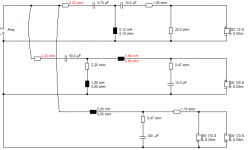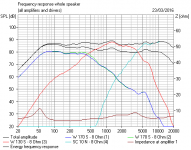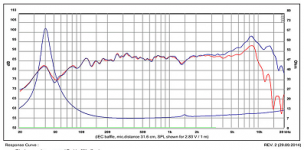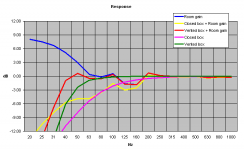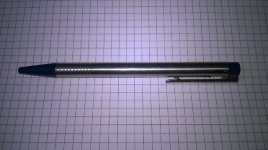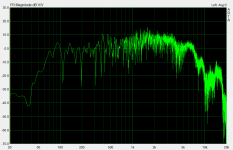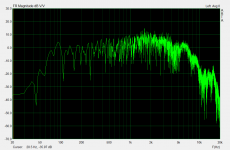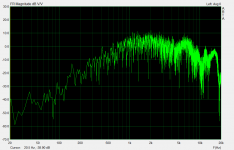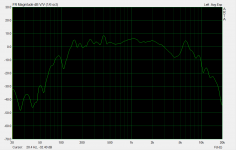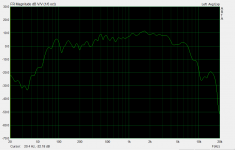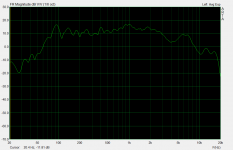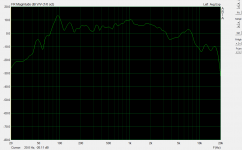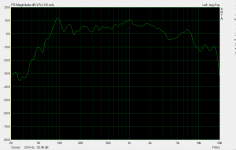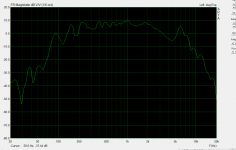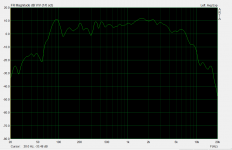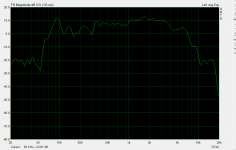I spent quite a lot of time this afternoon on this one. Guess it's fun, as Lojzek says. TBH, I like exploring new speaker ideas. 😀
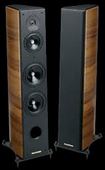
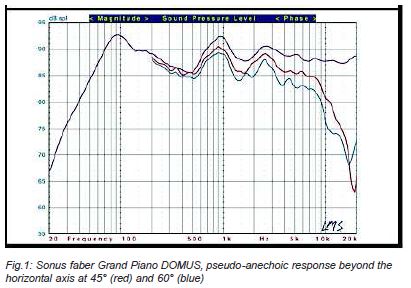
Let's remind ourselves, two SEAS 6" basses in parallel, slightly weird SEAS 5" mid with no dustcap and Vifa XT25 tweeter, we think. We're not sure about a lot, except it sounds wrong. 🙄
I've discovered some interesting things. Each bass has 2.2R in series with it. This will, of course, kill off the reflex damping and low Qts. So closed box is probably right. And putting a sock in the tube might help. 🙂
I moved a few components about and it all looks better. I really don't like the 0.33mH coil and tank in the midrange. All seems ineffectual. My gut tells me 0.68mH will work better for mid rolloff.
Not really huge changes. The bass ought to sound about 2dB louder and less flabby and lumpy. The lower rolloff of the mid is unaffected, but impedance improves.
There is small scope around 2dB to increase level on the mid and the tweeter. The mid unfortunately will then need new components (33uF and 2.7mH) to keep impedance up. The tweeter is easy. Just resistance changes.
So it's up to you, Davide, to have a listen and decide if the bass is intrusive and whether the mid and tweeter aren't playing nicely together at crossover. I am using different drivers, but the principles apply, er, I hope!


Let's remind ourselves, two SEAS 6" basses in parallel, slightly weird SEAS 5" mid with no dustcap and Vifa XT25 tweeter, we think. We're not sure about a lot, except it sounds wrong. 🙄
I've discovered some interesting things. Each bass has 2.2R in series with it. This will, of course, kill off the reflex damping and low Qts. So closed box is probably right. And putting a sock in the tube might help. 🙂
I moved a few components about and it all looks better. I really don't like the 0.33mH coil and tank in the midrange. All seems ineffectual. My gut tells me 0.68mH will work better for mid rolloff.
Not really huge changes. The bass ought to sound about 2dB louder and less flabby and lumpy. The lower rolloff of the mid is unaffected, but impedance improves.
There is small scope around 2dB to increase level on the mid and the tweeter. The mid unfortunately will then need new components (33uF and 2.7mH) to keep impedance up. The tweeter is easy. Just resistance changes.
So it's up to you, Davide, to have a listen and decide if the bass is intrusive and whether the mid and tweeter aren't playing nicely together at crossover. I am using different drivers, but the principles apply, er, I hope!
Attachments
Here is a full Sound and Vision Mag. review with LMS measurements that look eerily similar to those posted earlier. But even MORE strange is the center channel speaker test that has the same dips in almost the same places!!!! How can that be? the Center channel is a completely different design speaker.
http://www.soundandvision.com/conte...sound-system-measurements#eTeFf8gKh2AKGF3J.97
Was the designer going deaf when he voiced both the LR and center channels in the 5.1 system?.
In any case, we now have 2 data points (I think) showing much the same FR issues.
http://www.soundandvision.com/conte...sound-system-measurements#eTeFf8gKh2AKGF3J.97
Was the designer going deaf when he voiced both the LR and center channels in the 5.1 system?.
In any case, we now have 2 data points (I think) showing much the same FR issues.
It may be the engineer didn't have much choice here.

Between 500Hz and 3kHz we are very much seeing the midrange's performance. Which seems to roll off rather steeply after the 1.5kHz surround issue. Maybe that explains the small 0.33mH coil. 😕
A soft undamped surround on a 5" produces a dip at 1.5kHz. But the steep falloff afterwards looks like a heavily damped cone or perhaps lack of dustcap. Not ideal midrange material. I've seen this sort of driver before. Needs a low crossover for decent flat graphs.
SB acoustics Satori 5" MW13P-8 shows the 1.5kHz surround issue. Apparently the dip is not very offensive to the ear.
5" SATORI MW13P-8 :: SB Acoustics

Between 500Hz and 3kHz we are very much seeing the midrange's performance. Which seems to roll off rather steeply after the 1.5kHz surround issue. Maybe that explains the small 0.33mH coil. 😕
A soft undamped surround on a 5" produces a dip at 1.5kHz. But the steep falloff afterwards looks like a heavily damped cone or perhaps lack of dustcap. Not ideal midrange material. I've seen this sort of driver before. Needs a low crossover for decent flat graphs.
SB acoustics Satori 5" MW13P-8 shows the 1.5kHz surround issue. Apparently the dip is not very offensive to the ear.
5" SATORI MW13P-8 :: SB Acoustics
Attachments
I cannot work on the speaker now, but what I can do is ordering the components I need for few experiment in the meantime.
Another dumb question: do you have to experiment with both speakers or you can experiment with one only? Working in mono will let me leave one untouched and use it for reference.
Also what can I get as a starter kit as microphone? I only have a microphone that comes with the Denon Amp.
D
Another dumb question: do you have to experiment with both speakers or you can experiment with one only? Working in mono will let me leave one untouched and use it for reference.
Also what can I get as a starter kit as microphone? I only have a microphone that comes with the Denon Amp.
D
I don't wish to run down the measurement approach to loudspeakers, just that it's not an exact science.
Problem is that big bassy speakers in a small room are just very difficult. It's called Room Gain, and it gets steep. Nothing worse than bass that makes you jump out of your skin every time the band hits a bass note or drum.
Anything excessive in frequency response just says "Here I am" in a speaker and spoils the musical illusion. Anything over 2dB in Troel's opinion. 😕
I am sure your speakers are bass heavy. Best away from the wall. This is what you should be trying to sort out. Maybe placement matters too. Midrange clarity and level is easy to hear, and flat frequency response at the sweet spot doesn't tell you everything about power response around the room.
I always use favourite albums that I have heard on many different systems to judge tone. Like Dire Straits or Pink Floyd.
Problem is that big bassy speakers in a small room are just very difficult. It's called Room Gain, and it gets steep. Nothing worse than bass that makes you jump out of your skin every time the band hits a bass note or drum.
Anything excessive in frequency response just says "Here I am" in a speaker and spoils the musical illusion. Anything over 2dB in Troel's opinion. 😕
I am sure your speakers are bass heavy. Best away from the wall. This is what you should be trying to sort out. Maybe placement matters too. Midrange clarity and level is easy to hear, and flat frequency response at the sweet spot doesn't tell you everything about power response around the room.
I always use favourite albums that I have heard on many different systems to judge tone. Like Dire Straits or Pink Floyd.
Attachments
Also what can I get as a starter kit as microphone?
D
This a DIY forum so I would suggest building your own to keep
the costs down to a minimum. The pen comes handy as a housing
for the capsule. You solder some thin stranded wires to a capsule,
fill the tube with cotton wadding and install an appropriate socket.
I made such mic once with a Panasonic WM61 and it worked exactly
as good as Audiomatica Clio microphone I got with my measurement
gear.
Webshop Monacor - Qualitts-Subminiatur-Elektret-Mikrofonkapsel Submin-Elektret-Mikrofonkapsel MCE-4000
A complete and free measurement suite for all you will ever need to do:
ARTA Download
There is user manuals in German as well.
Attachments
ARTA, great SW, but a tough learning curve. Holm Impulse (also free) much easier learning curve.
I cannot work on the speaker now, but what I can do is ordering the components I need for few experiment in the meantime.
Another dumb question: do you have to experiment with both speakers or you can experiment with one only? Working in mono will let me leave one untouched and use it for reference.
Also what can I get as a starter kit as microphone? I only have a microphone that comes with the Denon Amp.
D
Of course, I prefer OmniMic! It's fast, reliable and integrates well with XSim 🙂 But it's pricey for many.
Otherwise the inexpensive miniature Dayton iMM-6 microphone should work with a PC and REW as the cheapest non-DIY solution I know of. Otherwise there's lots of ideas online about building your own mic. Blah. 😛
A tripod and USB extension cord are often good accessories.
I own one but don't do speaker analysis. I use it for home theater level calibration.
Best,
Erik
I am back.
I understand that it's not too difficult to make a DIY measurement setup, but in this moment I would not want to add to many variables to the problems.
So I was thinking to invest on something like the Behringer ECM8000 and the Blue Microphones Icicle XLR-USB.
Or, for a quick and cheap measurement I could use the Audiotools on the iphone 6. the microphone should not be that bad.
In any way, I understand that what would be needed is the frequency response of the mid and woofer. Should they be measured in the enclosure or on a test rig like an open baffle ?
The other option would be just to acquire some new Xover component and give a listen to system7 arrangement. The question in this case is: do I have to do it for both speaker, or one will give me a good idea of how things are going.
Thanks,
Davide
I understand that it's not too difficult to make a DIY measurement setup, but in this moment I would not want to add to many variables to the problems.
So I was thinking to invest on something like the Behringer ECM8000 and the Blue Microphones Icicle XLR-USB.
Or, for a quick and cheap measurement I could use the Audiotools on the iphone 6. the microphone should not be that bad.
In any way, I understand that what would be needed is the frequency response of the mid and woofer. Should they be measured in the enclosure or on a test rig like an open baffle ?
The other option would be just to acquire some new Xover component and give a listen to system7 arrangement. The question in this case is: do I have to do it for both speaker, or one will give me a good idea of how things are going.
Thanks,
Davide
Nikon,
The $12 Dayton measurement microphone is pretty good and can be used with your PC or phone.
You want to measure your drivers in cabinet , but without the crossover.
Also keep in mind you'll need impedance as well as frequency response. Again, the impedance for the woofers should come while they are in the cabinet.
One suggestion I had is you could also use miniDSP setup to create your target filter curves, but this would take 6 channels of amplification. It's a pretty useful prototyping tool, or you could even decide to make your speakers fully active. What makes me think of this is the midrange hump you'll need to deal with.
Of course, another possibility is to forego any crossover changes at all and use a miniDSP or similar to equalize your way to flat.
Best,
Erik
The $12 Dayton measurement microphone is pretty good and can be used with your PC or phone.
You want to measure your drivers in cabinet , but without the crossover.
Also keep in mind you'll need impedance as well as frequency response. Again, the impedance for the woofers should come while they are in the cabinet.
One suggestion I had is you could also use miniDSP setup to create your target filter curves, but this would take 6 channels of amplification. It's a pretty useful prototyping tool, or you could even decide to make your speakers fully active. What makes me think of this is the midrange hump you'll need to deal with.
Of course, another possibility is to forego any crossover changes at all and use a miniDSP or similar to equalize your way to flat.
Best,
Erik
Last edited:
So I borrowed a microphone, that maybe it's not really perfect for measurements. It's a Blue Yeti USB. This is what I obtained as FR using ARTA. Please let me know if these graph make sense.
I really apologize for being so slow in this development, lack of time :-(
How safe is this measurement without the filter for the tweeter ?
I'll try to measure now the original speaker.
Thanks,
Davide
I really apologize for being so slow in this development, lack of time :-(
How safe is this measurement without the filter for the tweeter ?
I'll try to measure now the original speaker.
Thanks,
Davide
Attachments
Just reminded myself where we've got to on this:
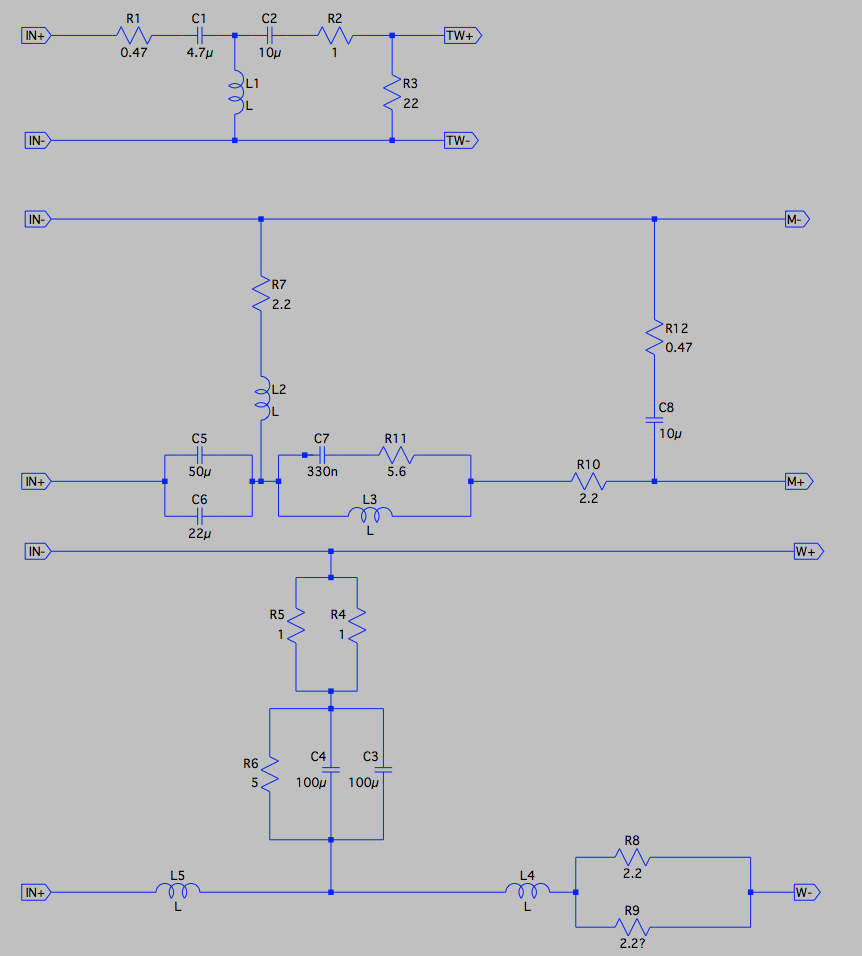


Suggested changes:
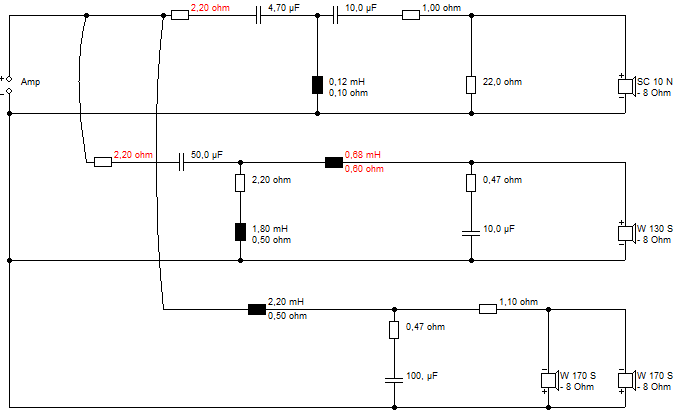
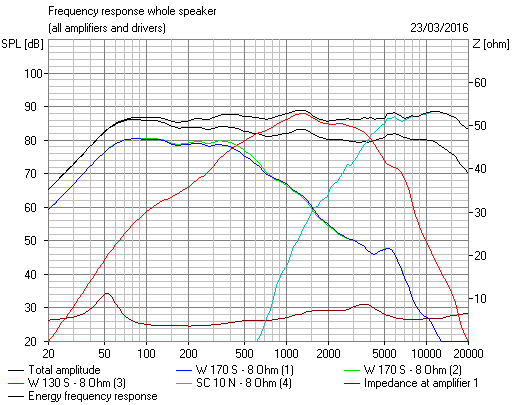
I have no idea what you are measuring there, or why, but I hope you don't fry your tweeter. What is wrong with the sound?



Suggested changes:


I have no idea what you are measuring there, or why, but I hope you don't fry your tweeter. What is wrong with the sound?
I did not do anything on the proposed new xover as I thought that some measurement could have used to refine it, before I buy the new components.
If this is not the case I'll just build the new one and give a listen.
Check the file names, they tell what I am measuring. Basically there are the FR measure of the single drivers in the bx without xover. The mic is at the height of the driver at 1 m distance.
I rewired the one speaker so that I have cables of the single drivers coming out, so that I can test the xover outside.
Thanks,
Davide
If this is not the case I'll just build the new one and give a listen.
Check the file names, they tell what I am measuring. Basically there are the FR measure of the single drivers in the bx without xover. The mic is at the height of the driver at 1 m distance.
I rewired the one speaker so that I have cables of the single drivers coming out, so that I can test the xover outside.
Thanks,
Davide
Now that I put everything back in place, I realized that I forgot to take the plug out of the bass reflex pipe, so, if needed, I have to do it again.
D.
D.
- Status
- Not open for further replies.
- Home
- Loudspeakers
- Multi-Way
- Sonus Faber Grand Piano Domus
